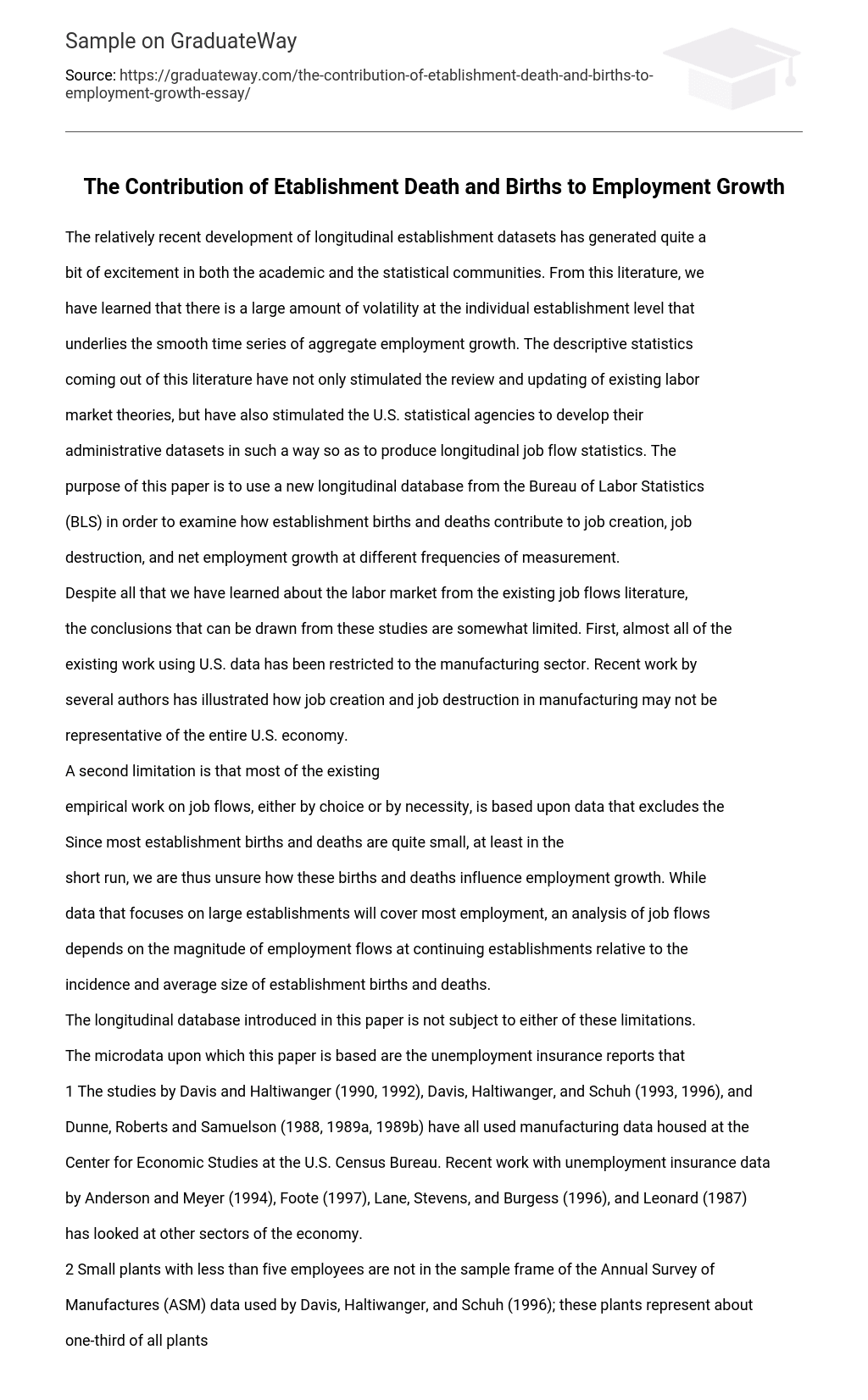The relatively recent development of longitudinal establishment datasets has generated quite a bit of excitement in both the academic and the statistical communities. From this literature, we have learned that there is a large amount of volatility at the individual establishment level that underlies the smooth time series of aggregate employment growth. The descriptive statistics coming out of this literature have not only stimulated the review and updating of existing labor market theories, but have also stimulated the U.S. statistical agencies to develop their administrative datasets in such a way so as to produce longitudinal job flow statistics. The purpose of this paper is to use a new longitudinal database from the Bureau of Labor Statistics (BLS) in order to examine how establishment births and deaths contribute to job creation, job destruction, and net employment growth at different frequencies of measurement.
Despite all that we have learned about the labor market from the existing job flows literature, the conclusions that can be drawn from these studies are somewhat limited. First, almost all of the existing work using U.S. data has been restricted to the manufacturing sector. Recent work by several authors has illustrated how job creation and job destruction in manufacturing may not be representative of the entire U.S. economy. A second limitation is that most of the existing empirical work on job flows, either by choice or by necessity, is based upon data that excludes the Since most establishment births and deaths are quite small, at least in the short run, we are thus unsure how these births and deaths influence employment growth.
While data that focuses on large establishments will cover most employment, an analysis of job flows depends on the magnitude of employment flows at continuing establishments relative to the incidence and average size of establishment births and deaths. The longitudinal database introduced in this paper is not subject to either of these limitations. The microdata upon which this paper is based are the unemployment insurance reports that The studies by Davis and Haltiwanger (1990, 1992), Davis, Haltiwanger, and Schuh (1993, 1996), and Dunne, Roberts and Samuelson (1988, 1989a, 1989b) have all used manufacturing data housed at the Center for Economic Studies at the U.S. Census Bureau.
Recent work with unemployment insurance data by Anderson and Meyer (1994), Foote (1997), Lane, Stevens, and Burgess (1996), and Leonard (1987) has looked at other sectors of the economy. Small plants with less than five employees are not in the sample frame of the Annual Survey of Manufactures (ASM) data used by Davis, Haltiwanger, and Schuh (1996); these plants represent about one-third of all plants and about 4 to 7 percent of employment. Using the Census of Manufactures, Dunne, Roberts and Samuelson (1989a) exclude manufacturing plants with less than 5 employees; these excluded plants account for between 30 and 40 percent of all plants but represent only one percent of employment. The firm sample used by Anderson and Meyer (1994) includes only firms with at least 50 employees; this sample accounts for 83 percent of employment.
References
- Anderson, Patricia M. and Bruce D. Meyer. 1994. “The Extent and Consequences of Job Turnover.” Brookings Papers on Economic Activity, pp. 177-236.
- Audretsch, David B. and Talat Mahmood. 1994. “The Rate of Hazard Confronting New Firms and Plants in U.S. Manufacturing.” Review of Industrial Organization, pp. 41-56.
- Baldwin, John R. and Paul K. Gorecki. 1989. “Measuring Firm Entry and Exit With Panel Data.” Proceedings of the Statistics Canada Symposium on Analysis of Data in Time.
- Baldwin, John R. and Paul K. Gorecki. 1991. “Firm Entry and Exit in the Canadian Manufacturing Sector, 1970-1982.” Canadian Journal of Economics, pp. 300-323.
- Boeri, Tito. 1996. “Is Job Turnover Countercyclical?” Journal of Labor Economics, pp. 603-625.
- Boeri, Tito and Lutz Bellmann. 1995. “Post-entry Behaviour and the Cycle: Evidence from Germany.” International Journal of Industrial Organization, pp. 483-500.
- Boeri, Tito and Ulrich Cramer. 1992. “Employment Growth, Incumbents, and Entrants.” International Journal of Industrial Organization, pp. 545-565.
- Brüderl, Josef and Rudolf Schüssler. 1990. “Organizational Mortality: The Liabilities of Newness and Adolescence.” Administrative Science Quarterly, pp. 530-547.
- Brüderl, Josef, Peter Preisendörfer, and Rolf Ziegler. 1992. “Survival Chances of Newly Founded Business Organizations.” American Sociological Review, pp. 227-242.
- Davis, Steven J. and John C. Haltiwanger. 1990. “Gross Job Creation and Destruction: Microeconomic Evidence and Macroeconomic Implications.” NBER Macroeconomics Annual, pp. 123-168.
- Davis, Steven J. and John C. Haltiwanger. 1992. “Gross Job Creation, Gross Job Destruction, and Employment Reallocation.” Quarterly Journal of Economics, pp. 819-863.
- Davis, Steven J. and John C. Haltiwanger. 1995. “Measuring Gross Worker and Job Flows.” NBER Working Paper #5133.
- Davis, Steven J., John C. Haltiwanger, and Scott Schuh. 1993. “Small Business and Job Creation: Dissecting the Myth and Reassessing the Facts.” NBER Working Paper #4492.
- Davis, Steven J., John C. Haltiwanger, and Scott Schuh. 1996. Job Creation and Destruction. MIT Press.
- Dunne, Timothy, Mark J. Roberts, and Larry Samuelson. 1988. “Patterns of Firm Entry and Exit n U.S. Manufacturing Industries.” Rand Journal of Economics, pp. 495-515.





